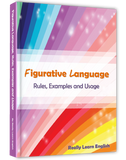Share this product
The complete guide to figurative speech and writing, including: similes and metaphors, idioms, clichés, puns and others.
To truly understand English, you must have some knowledge of the most common types of figurative language.
What does figurative mean?
Figurative means that words are used in a way that is different from the usual meaning. That way the description is more interesting or impressive. Figurative language creates a picture in your mind.
For example:
He is about to explode!

We do not mean to say that the man will actually explode. We only want to say that he is extremely angry.
So we use the verb "explode" in a figurative way. In other words, we use a word that usually describes something else.
That way the description is more interesting. It creates a certain picture in the mind.
The opposite of figurative is literal
Literal means that you mean what you say exactly.
For example:
He is about to explode!

Here we do mean to say that the man will actually explode. The man holds fireworks, and it looks dangerous enough to explode.
So here we use the verb "explode" in a literal way.
In other words, we use the usual meaning of the word.






